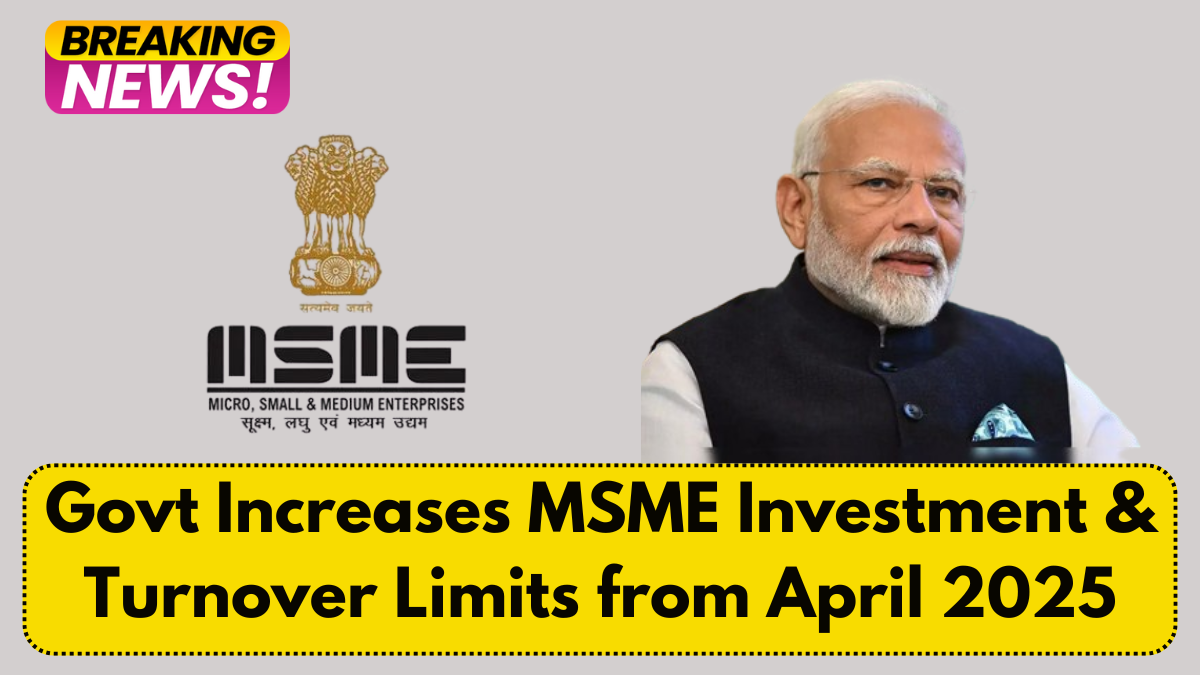The Ministry of Micro, Small, and Medium Enterprises (MSME) has officially revised the classification criteria for MSMEs by increasing the investment and turnover limits. These changes will take effect from April 1, 2025. The revision aims to facilitate business growth by allowing enterprises to expand while still enjoying the benefits of MSME status.

Overview of the Revised MSME Classification
Previously, enterprises were categorized based on investment in plant and machinery or equipment and their annual turnover, as per the notification S.O. 2119(E) issued on June 26, 2020. However, with the evolving economic landscape, the government has recognized the need to update these limits to reflect inflation, business expansion, and increased production costs.
New MSME Classification Limits
The revised classification introduces increased thresholds for each category, ensuring that more businesses can qualify for MSME benefits. Below is a detailed comparison of the old and new limits:
| Enterprise Category | Previous Investment Limit | New Investment Limit | Previous Turnover Limit | New Turnover Limit |
|---|---|---|---|---|
| Micro Enterprise | Up to ₹1 crore | Up to ₹2.5 crore | Up to ₹5 crore | Up to ₹10 crore |
| Small Enterprise | Up to ₹10 crore | Up to ₹25 crore | Up to ₹50 crore | Up to ₹100 crore |
| Medium Enterprise | Up to ₹50 crore | Up to ₹125 crore | Up to ₹250 crore | Up to ₹500 crore |
Impact of the New Classification on MSMEs
1. Broader Eligibility for MSME Benefits
By increasing the investment and turnover limits, the government allows businesses to expand without losing their MSME status. This enables them to continue enjoying various benefits, including easier access to finance, subsidies, and priority in government procurement.
2. Improved Access to Credit and Financial Support
MSMEs often struggle with securing loans due to their size and financial limitations. The revised limits will allow growing businesses to access credit facilities under various MSME support schemes, such as:
- Collateral-free loans under the Credit Guarantee Fund Trust for Micro and Small Enterprises (CGTMSE)
- Subsidized interest rates under government-backed financing programs
- Enhanced credit limits under emergency relief measures
3. Encouragement for Business Growth and Expansion
With higher classification thresholds, businesses can scale up production, increase workforce hiring, and explore new markets without fear of losing their MSME benefits. This fosters a more competitive and resilient business ecosystem.
4. Strengthened Role of MSMEs in the Indian Economy
The MSME sector is a crucial driver of economic growth, contributing significantly to GDP, exports, and employment. By supporting larger MSMEs, the government aims to:
- Boost industrial and service sector outputs
- Enhance global competitiveness of Indian businesses
- Create more job opportunities
5. Government’s Commitment to MSME Development
Dr. Rajneesh, Additional Secretary & Development Commissioner, signed the notification, reinforcing the government’s dedication to strengthening the MSME sector. This move aligns with India’s broader economic reforms to make the country a global manufacturing and business hub.
Also Read: Retirement Age Hike 2025: Will It Increase to 62 from 60? Key Details Inside
Key Takeaways
- The revised classification will take effect from April 1, 2025.
- Investment and turnover limits for MSMEs have been significantly increased.
- MSMEs can now expand while still retaining their classification benefits.
- The update enhances access to financial support, promotes business growth, and strengthens economic contributions.
Conclusion
The revision in MSME classification represents a proactive approach by the government to support businesses, foster economic growth, and strengthen India’s industrial sector. These changes will enable more enterprises to thrive while benefiting from policies tailored to their growth and sustainability. As the new limits take effect from April 1, 2025, businesses should prepare to leverage these changes for expansion and long-term success.
Frequently Asked Questions (FAQs)
1. Why has the government revised the MSME classification limits?
The revision aims to support business growth, account for inflation, and ensure MSMEs remain competitive while continuing to benefit from government schemes.
2. How will this affect existing MSMEs?
Existing MSMEs that previously exceeded the old limits but fall within the new thresholds can now requalify for MSME benefits. Those already classified as MSMEs will enjoy an extended scope for expansion.
3. Will businesses need to re-register under the new classification?
No, businesses already registered under the MSME framework will automatically fall into the updated classification based on their current investment and turnover.
4. What benefits do MSMEs receive under government schemes?
MSMEs receive several benefits, including collateral-free loans, lower interest rates, tax incentives, subsidies, easier access to government contracts, and priority in procurement.
5. How will this impact employment in the MSME sector?
With increased thresholds, MSMEs can expand their workforce, leading to more job opportunities and economic growth.
For More Information Click Here
Akesh is a furniture expert with years of experience in design and craftsmanship. Specializing in sustainable materials, he shares his expertise to help people create stylish and functional living spaces.
